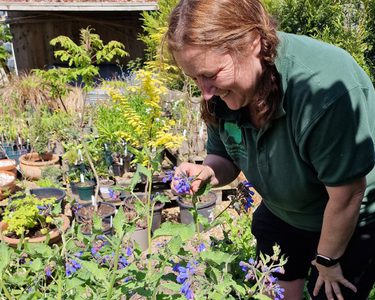We've been awarded the National Plant Collection for comfrey

To be granted the National Plant Collection for Symphytum (comfrey) is a glowing accolade for our work documenting, developing and preserving a comprehensive collection at our organic demonstration garden in Ryton near Coventry. This is already the location for our Heritage Seed Library, which has National Plant Collection status.
Head gardener Emma O’Neill says: “We’ve worked hard to establish and preserve 29 varieties of comfrey - and are always on the lookout for new varieties of this important plant. We’re committed to conserving a diverse range of garden plants to protect plant diversity and crucially to boost biodiversity. Our Heritage Seed Library already conserves and protects 800-plus historic heritage varieties."
Gill Groombridge, business manager at Plant Heritage said: “Garden Organic has expertly cared for the Heritage Seed Library – a hugely important resource – for 15 years, so we’re delighted they also now have a comfrey collection too. Without collection holders like Garden Organic, our ongoing plant conservation work wouldn’t be possible."
Rich in plant nutrients
We’ve been growing comfrey throughout our 65-year history as our founder Lawrence Hills led experiments using the herb, which showed it was an excellent natural fertiliser. Hills’ experiments took place in the village of Bocking, near Braintree, and many of his trials were named after the village – with Bocking 14 eventually identified as one of the most nutritious varieties of comfrey and least likely to self-seed.
Comfrey leaves are rich in valuable plant nutrients including nitrogen, phosphorus and potassium, which once steeped in water create a wonderful organic fertiliser. Comfrey fertiliser will boost leaf growth, promote root development and help flowers and fruit to form.
Comfrey also produces beautiful flowers that attract bees and hoverflies essential for pollination. It makes a great ground cover, an effective mulch and helps break up tough soil.
Plant Heritage National Collections
Horticultural conservation charity Plant Heritage currently oversees 95,000 plants held in more than 700 different National Plant Collections spread across the country. These ‘living libraries’ are a vital resource for plant conservation, and protect and keep many different plant groups alive, ensuring they remain in cultivation. Collection holders range from passionate individuals to botanic gardens, plant nurseries, local authorities and charities.
Gill added: “Given the ever-changing climate issues we face, it’s vital that new National Plant Collections are accredited, as this ensures that a range of plants remain in cultivation for future generations while benefitting the wider environment.”
Varieties of comfrey grown and preserved in our garden
Prefix to all: Symphytum
‘Goldsmith’
tuberosum
rubrum
‘Langthorns Pink’
asperum
grandiflorum ‘Wisley Blue’
‘Hidcote Blue’
‘Angela Whinfield’
officinalis ‘Norfolk’
officinale
cordatum
‘Hidcote Variegated’
ibericum ‘All Gold’
officinalis ‘Macpenny Pink’
orientale
ibericum
caucasicum
grandiflorum
x uplandicum ‘Moorland Heather’
bulbosum
x uplandicum
ibericum ‘Blaueglocken’
‘Hidcote Pink’
X uplandicum ‘Axminster Gold’
‘Belsay’
‘Romanian Red’
X uplandicum ‘Variegatum’
azeureum
‘Lambrook Sunrise’
To learn how to grow, harvest and use comfrey head to our Comfrey Hub here. If you'd like to see the Collection for yourself, book on one of our Garden Tours in 2024.
